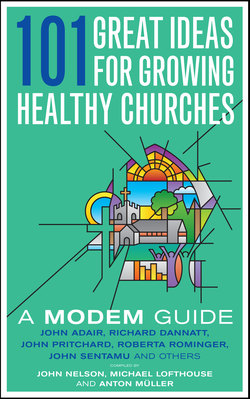Читать книгу 101 Great Ideas for Growing Healthy Churches - John Nelson - Страница 9
На сайте Литреса книга снята с продажи.
ОглавлениеA Spiritual Reflection on 101 Great Ideas for Growing Healthy Churches
ANTON MÜLLER
All of us, in whatever walk of life, need to be able to manage. Often we may hear someone say to another ‘How are you managing?’ Rarely do we hear the answer.
During my time as the spiritual care co-ordinator for a hospice I learned that enabling people to manage their terminal or life-limiting illness was something which required much more than the administering of pain-relieving drugs. In the face of terminal or long-term illness what was needed for each patient was an internal strategy for facing and coping with the world that was not only changing dramatically but seemed to be moving on without them. Of some patients it would be said, ‘they have turned their face to the wall’.
Once in that frame of mind it was very hard to enable a patient to turn back and proceed with their journey through the world. Unless there is a strategy for facing this most important of journeys then to turn and face the wall is often the only option.
It is fundamental to our Christian theology that the fullness of life takes us through the journey of death. It cannot be avoided or ignored. The purpose of administering pain-relieving drugs in modern hospice care is to give each patient the opportunity to live until they die. To live life in all its fullness, with dignity and with quality.
Too often I see churches that have turned their faces to the wall and have cut themselves off from the world. They are stuck on the pain-relieving drugs of the past. They look to their past glories and past achievements rather than looking where they are in the now and where they are called to go in the future.
All churches have a past, a present and a future. For some that future may mean a closure, an ending, a death, while for others it may mean living in a new way. This is the way ahead for every church. Both scenarios require careful management and a strategy for dealing with the different kinds of closures ahead. Both scenarios have the possibilities for a new way of being.
If this were not so for a church then that church has not been living its life according to the theology which underpins our Christian faith. I recently heard about how the closure of one struggling church gave new life and growth to other churches around it. The death of one church gave new hope and being for the remnant of that church who found new life and ministry in the way forward. That church is growing.
A healthy church is one that understands that its life is based upon God’s greatest idea – that of death and resurrection.
Every contribution in this book is a pointer to living a forward-thinking life. There are no contributions that talk about maintaining the status quo. Every contribution is offered as a strategy for managing the abundance of life to which God is calling every Christian and every church.
Given the opportunity to write a short quote of my own, it would be this: ‘Managing the status quo of the church is called juggling. Managing the forward movement of the church is called strategy.’
I have no doubt that Jesus could have juggled if he wanted to, but instead he chose to stretch out his arms in a loving embrace that brings life and new ways of living and being.
I share with my editorial colleagues a great sense of the privilege that we have experienced in compiling these 101 Great Ideas. We are privileged now to share these with you as you seek to build your own strategy for embracing the world as whole and healthy churches.
